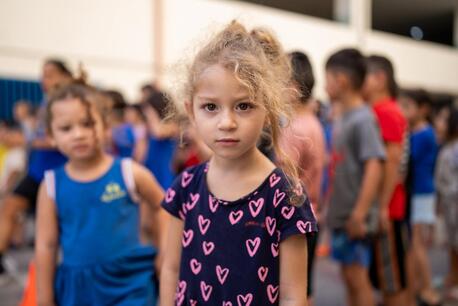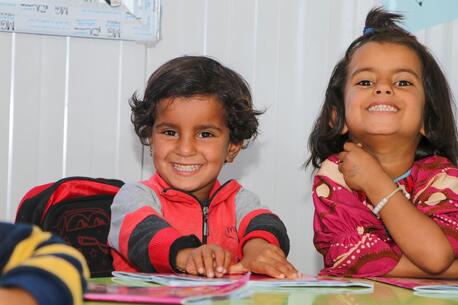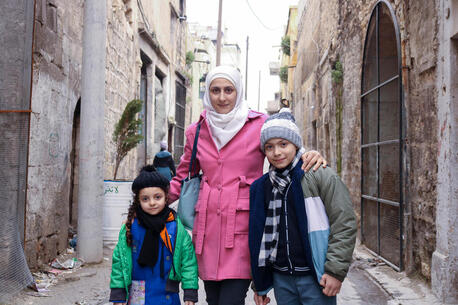
Report from Aleppo: Displaced Children & Families Huddle in Jibreen
Eastern Aleppo has become a living hell for children. UNICEF Syria's Country Representative reports on the state of children in the embattled city and other besieged areas where half a million children are trapped in deteriorating conditions.
UPDATE 1/1: Children Displaced from East Aleppo: Traumatized, Injured and Alone
UPDATE 12/19: Statement by Geert Cappelaere, UNICEF Regional Director, on Evacuation of East Aleppo Orphanage
“The evacuation of these orphans, along with thousands of other children from east Aleppo in the past days is a glimmer of hope amid a grim reality for the children of Syria. Their safe departure is a testimony to the relentless efforts of humanitarians on the ground, working around the clock for children and their families.
UPDATE 12/16: Statement by Anthony Lake, UNICEF Executive Director, on Children Trapped in Aleppo
*************************************************
Hanaa Singer is UNICEF's Country Representative in Syria.
I have just travelled back from Aleppo, where the situation continues to plummet to even greater lows.
1yr old Baby Rukaia her family of 7 escaped fighting in E/#Aleppo 1week ago Rukkaia &5K children received winter clothes provided by @UNICEFpic.twitter.com/19wiJfeZpH
— Hanaa Singer (@SingerHanaa) December 10, 2016
When I was there nearly 100 mortars fell on west Aleppo in a couple of days. While at the same time, only a few hundred meters away we witnessed the unrelenting bombardment of the eastern side of the city.
There is no safe place in Aleppo. Even going to school can be a matter of life or death.
My colleagues told me that they hid in bathrooms and basements as the attacks continued. There was little sleep that night. The very same staff came to work in the morning with the same energy, as if it was just an ordinary night.

Rain falls in the yard of a large warehouse in Jibreen, Aleppo, now used as a shelter for thousands of families who fled violence in east Aleppo. It is reported that some 31,500 people have been displaced from and within the area since 24 November, including around 19,000 children.
Relentless Shelling, Even for Syria
Even by Syrian standards, the recent bombardment and shelling have been the most intense in Aleppo. Some 31,500 people have been displaced from east Aleppo in just 10-days. At least 50 percent of the displaced persons seem to be children.
I travelled to one of the shelters for displaced persons in Jibreen on the outskirts of the city. It’s a large warehouse where families huddled together on mattresses on the floor. The damp and piercing cold made the conditions even tougher.
Children shared stories to the soundtrack of the deafening noise of explosions.
To the soundtrack of the deafening noise of explosions and firing of heavy weapons, the children, who were attending psychosocial support activities, shared some stories. They told of how they cowered for days and weeks in dark and damp basements in fear of the shelling in besieged east Aleppo. They shared their dark memories of destruction, and the smell of dead bodies under the rubble.
There was little sleep that night, but the same staff came to work in the morning with the same energy, as if it was just an ordinary night.
Then I visited Hanano, a neighborhood in east Aleppo that was retaken by government forces on 27 November. More than 6,000 people have returned.
The destruction was massive. Unexploded ordnance scattered everywhere. Apartments were gutted, hospitals nearly destroyed and schools completely damaged except for two that could be rehabilitated.
But surprisingly people were still going back. To try and rebuild their shattered houses and lives. For you see, people just want to go home.
Despite wanting to return, there is no safe place left in Aleppo. Even going to school can be a matter of life or death. This year there have been 84 attacks on schools in Syria with at least 69 children losing their lives and many others injured while being at school.
.@UNICEF & @UN agencies provide winter clothes to #children & families recently fled fighting in east #Aleppo city pic.twitter.com/2Vd8EOFaVb
— Hanaa Singer (@SingerHanaa) December 4, 2016
UNICEF Steps Up Relief for Eastern Aleppo
In response to the latest displacement in Aleppo, UNICEF staff are working around the clock to make life a little more bearable for children.
Winter clothes are being distributed and water is being trucked to shelters and areas where people are returning, like Hanano.
We are providing fuel, repairs and maintenance of Aleppo’s water network so 1.2 million people have access to safe water.
Nearly 7,000 children and mothers have been reached with critical routine immunizations.
We are providing fuel and repairs so 1.2 million people can access safe water.
Mobile health clinics have screened over 1,600 children for malnutrition and distributed nutritional supplements.
Mine risk education and psychosocial support services are reaching some 6,000 children.
These simple immediate interventions can save lives.
.@UNICEF & partners educate displaced families from East #Aleppo on mine risks as they are exposed to unexploded remnants of war pic.twitter.com/CPQsiowvPm
— Hanaa Singer (@SingerHanaa) December 4, 2016
A Dire Situation, A Severe Need
Although the world’s attention is on Aleppo, sadly the scale of suffering is widespread. East Aleppo is one of 16 besieged areas, where we estimate that nearly half a million children remain trapped amid worsening conditions.
Madaya – home to 45,000 people – is another of the besieged areas. When I last went with our team to the town I was shocked by what I heard. People surviving on leaves and grass.
I was taken to what was called the "health center". It was, in fact, one room in the basement of a house. Ushered into the semi-darkness, I was met by the sight of limp bodies lying on blue blankets on the floor.
The "health center" was, in fact, one room in the basement of a house.
The doctor, the only pediatrician in town, took me to the one and only bed. It had what appeared to be two bundles. As I looked closer in the darkness I was startled. It was actually two skeleton like young men. They were drifting in and out of consciousness.
Even with the extreme deprivation, we got right to work trying to halt locals' downward spiral of starvation. We conducted training on how to use the therapeutic food and treatments we brought with health workers and volunteers present.
The sad reality of #Syria's children: two boys displaced by fighting in #Aleppo have to burn anything they can find to keep themselves warm. pic.twitter.com/5lWuzLmYBX
— Unicef UK (@UNICEF_uk) December 3, 2016
A Reason for Hope
In my daily work I have always been in awe of the extraordinary stories of children’s determination and resilience. Like the 12,000 children who risked their lives to cross active conflict lines, to sit for their national final exams. These courageous youngsters will build the future Syria.
The children of Syria are not giving up and nor can we. UNICEF is committed to doing what we can to support them and to provide opportunities wherever we can.
And so we work: In 2016 alone, we provided 3.2 million children with text books and school supplies - rehabilitated schools and added thousands of temporary learning spaces.
In 2016, we provided 3.2 million children with school supplies, rehabilitated schools and thousands of temporary learning spaces.
With UNICEF, routine immunization coverage has been boosted from a national average of 50% to 75%. Polio vaccinations stopped the deadly disease - with no new cases for almost three years.
Syrian families, and Syrian children, have one major desire: to return to their homes, to live in peace, and contribute to the reconstruction of their beautiful country. We need to provide them with the opportunity to do just that.
Stand For Hope: Please support UNICEF's efforts to help the children of Syria.
HOW TO HELP
There are many ways to make a difference
War, famine, poverty, natural disasters — threats to the world's children keep coming. But UNICEF won't stop working to keep children healthy and safe.
UNICEF works in over 190 countries and territories — more places than any other children's organization. UNICEF has the world's largest humanitarian warehouse and, when disaster strikes, can get supplies almost anywhere within 72 hours. Constantly innovating, always advocating for a better world for children, UNICEF works to ensure that every child can grow up healthy, educated, protected and respected.
Would you like to help give all children the opportunity to reach their full potential? There are many ways to get involved.





